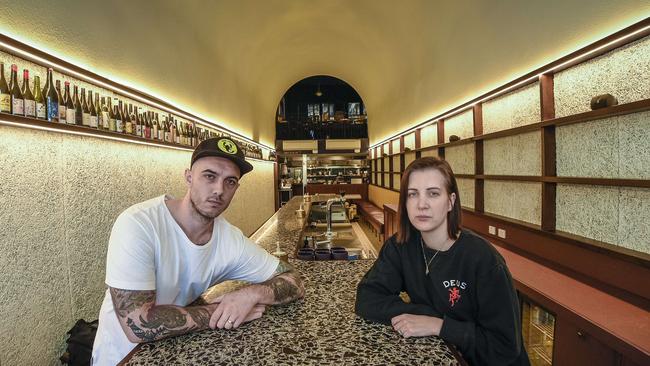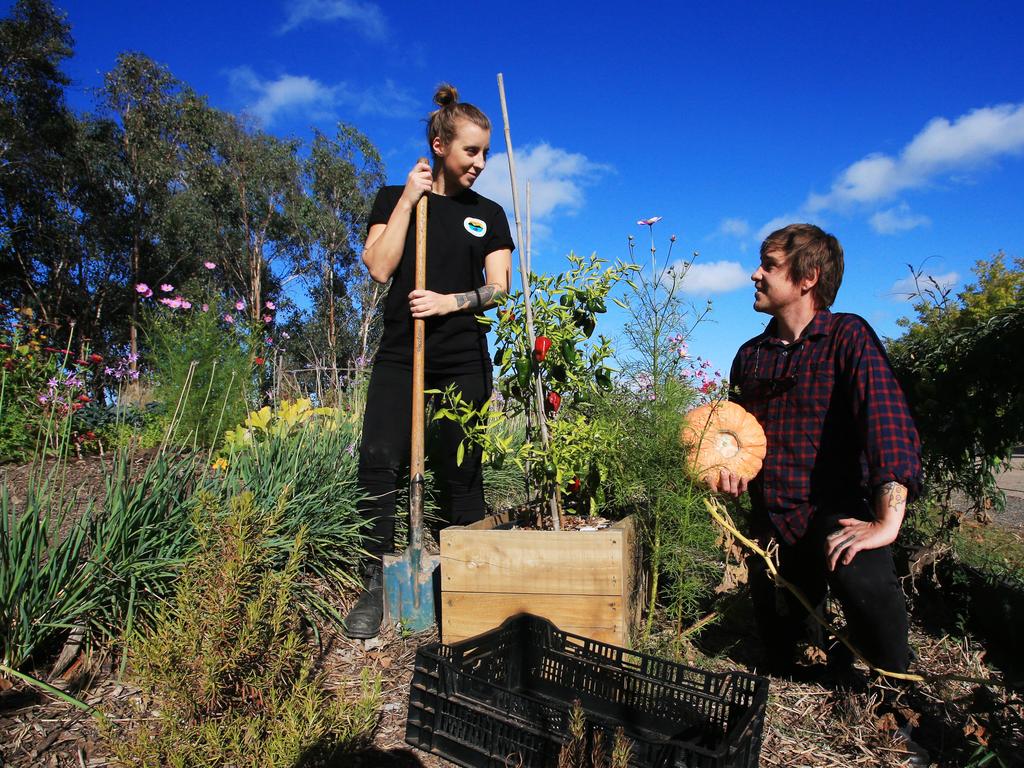Coronavirus: life’s dream at breaking point
It’s a scenario being played out on repeat across Australia: when a pandemic means hard work and a good plan count for absolutely nothing.

Sali Sasi opened the door of her Adelaide restaurant late last week — an event in itself these days — to a delivery guy with a stack of exotic wine and an invoice for $7500.
Like every other restaurateur in Australia, she has nobody to sell it to. It was ordered months ago, and Sasi felt an obligation to proceed with the deal, despite the industry’s ruined state.
“You can’t just send it back,” says half the partnership behind Leigh Street Wine Room, a small but highly successful — until March 22, that is — natural wine bar with food by her chef husband, Nathan Sasi. “Making sure those distributors and producers are still in business post-pandemic is crucial.”
From a business with no real turnover, it was an exceptional response; wine distributors are just part of a matrix of restaurant suppliers across the country haemorrhaging as orders are cancelled for everything from sangiovese to salami. And for the Sasis, it was yet another reminder that just because the music has stopped, you don’t necessarily get to sit down.
It was never going to be easy for the couple, but on paper Leigh Street Wine Room made sense. Like so many before them, the husband-and-wife team had the ambition of a wine-focused restaurant-bar, some savings and the skill set to pull it off. After a career working in other people’s restaurants, they honed the concept; finetuned the business plan; found the right premises; and worked on a budget.
Nobody was going to say Nathan Sasi’s plan hadn’t been properly executed. They found finance to supplement their own capital and, by the time they opened LSWR at the thriving heart of Adelaide’s hippest CBD food-and-wine ghetto, the couple was $660,000 in the hole.
No omelet was ever made without breaking an egg or three.
And this was a well-run and ostensibly successful business that had everything going for it. In other words, not your typical restaurant. A bustling — boisterous, even — venue in a cool part of town (with a reputation for excellence), LSWR was doing well in the weeks leading up to D-Day, March 22.
Yet LSWR is neither big nor fancy; nobody would look at the transformed former dry cleaners and say they’d bitten off more than they could chew. And, while the chef’s reputation was made in Sydney, his talents were well-documented long before the couple moved to South Australia, bought an existing business for $30,000 simply to get the lease and started building in June last year.
But an examination of the costs involved in getting the business open highlights both the unexpected dollars that needed shelling out and the ongoing obligations that have such powerful knock-on effects for other businesses.
The cost of equipping a small commercial kitchen, for example — $150,000, paid for with a typical rent/buy agreement costing the business $1700 a week across 12 months with a buyout figure of $70,000. It may sound an indulgence, but for a restaurant the cost of unreliable equipment is on a par with a courier driving a dodgy van. A designer’s fee of $30,000; builders’ costs of $300,000 and furnishings, even for a 40-seater, of $50,000. With somewhat obscure wine at the core of their business plan, the Sasis had spent $100,000 on stock even before doors opened at 5pm Wednesday, September 4, last year.
Good thing the reviews were strong.
They had employed six full-time staff and five casuals, one on a student visa. Because the business was less than 12 months old, the casuals are ineligible for JobKeeper. Wages — three weeks of staff training before opening, for example, cost $20,000 — were just the start of a raft of weekly, monthly and quarterly costs the couple now had on their shoulders Some, like rent ($6500 a month) or gas (latest bill $4255.15), were obvious factors at the core of any business budget, along with insurance ($554 a month) or superannuation entitlements (last payment $10,000). Ditto interest on various loans — one for $200,000, another for $50,000. And the collection of GST, a percentage of sales.
It’s the behind-the-scenes costs a newcomer to their own business may not factor in, from $12 a month to Spotify to a variety of software and transaction subscriptions and other office-related costs of more than $3000 a month. Who among us knew the EFTPOS facility we so happily take advantage of is costing the restaurant around $694 a month? Then there are the creditors — those still owed money for outstanding invoiced sales — who constitute some of the most vulnerable businesses when their customer suddenly stops trading.
Leigh Street had been taking, on average, $40,000 a week; its best week, in a lifespan of just seven months, $52,000, three weeks before the shutdown. But by the time March 20 arrived — the weekend boom — restaurant distancing rules had come into force, effectively reducing the numbers at a minimal personal-space venue such as Leigh Street by 75 per cent. They took $25,000 that week: Nathan Sasi reckons their break-even point is around $35,000 a week. The couple — both of whom take a wage from the business — had prioritised debt reduction paying down $60,000 on their principal loan in seven months, “hence we didn’t leave much money for contingency”, Sali Sasi says.
On Sunday, March 22, they owed creditors $47,645 for everything from stationery to oysters; around $18,000 in wages they had to find before federal government assistance is paid retrospectively; another $4000 in staff entitlements they wanted to pay forward; and $10,000 due in superannuation. They had $80,000 in their trading account.
Some invoices, such as Officeworks, were minuscule; others, such as niche wine importer-distributor Andrew Guard, one of several wine suppliers to Leigh Street, totalled $7138.83.
“I had $120,000 worth of orders cancelled in a week,” says Guard. “I knew it was going to happen, but it was still disheartening.”
Guard is not given to hyperbole. “Businesses that were well managed and well run — prudently run — will be better prepared to weather this,” he says. “We’ve all got debtors. But there are some restaurants and some importers more vulnerable than others.”
Phillip Godkin, chief executive of SilverChef, the equipment brokerage Leigh Street is contracted to, says his company has “around $300m” in equipment it owns in restaurants around the country right now. “A large number of our customers can’t pay, they have no cashflow,” Godkin says. “It has a very material flow-on effect in terms of our own cashflow … I wouldn’t describe it as a disaster, but it’s a crisis.”
When Inquirer spoke to the Sasis on Friday, they had paid out $30,000, with $38,764 still outstanding. They are developing an alternative interim business model — an online sister company — and spent $15,000 already, Sali Sasi says, “purely to be able to sell the current stock on hand as a way to hopefully generate some revenue”, and the rent is on pause. For now.
They are concerned for their niche suppliers, 90 per cent of whom rely solely on the restaurant trade. From oyster growers to buffalo dairy farmers, says Nathan Sasi, his restaurant — and by extension many more — relies on small direct-supply grower specialists whose business is almost entirely built around the premiums restaurants pay to bypass wholesalers. Many will be in jeopardy. But with personal debt (a mortgage) and two young children, the Sasis are unsurprisingly focused on their own predicament.
“The biggest thing is the unknown, if we just knew when,” says the chef. “It’s the slow bleed-out. We think we can get through it but anything longer than six months and I won’t be able to reopen.”
Sali Sasi refers to themselves now as “Centrelink babies”. “You feel you’ve worked so hard your whole life,” she says, “and now you’ve been forced into a situation of having to be the people we have never wanted to be.”







To join the conversation, please log in. Don't have an account? Register
Join the conversation, you are commenting as Logout